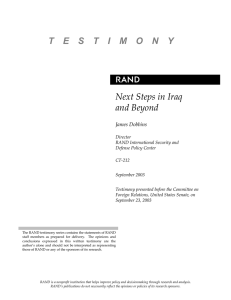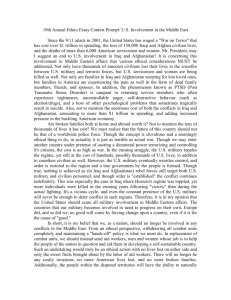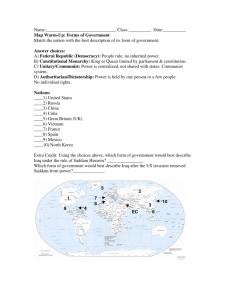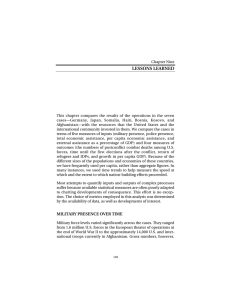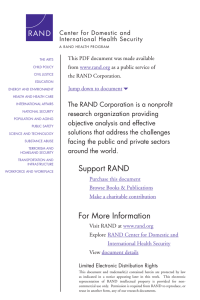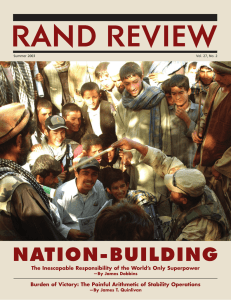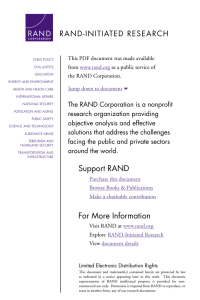T E S T I M O N Y
advertisement
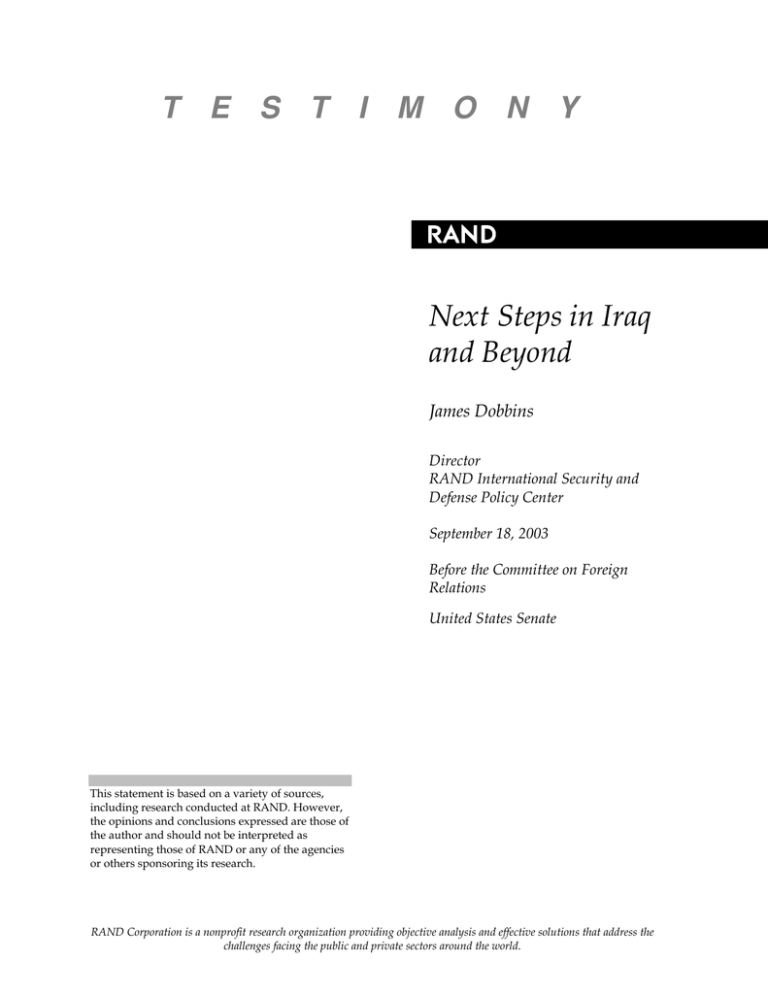
T E S T I M O N Y !"##$ % & ' ( % ' % ' ) '% * ' + * * %, * - % % Statement of James Dobbins Director of RAND International Security and Defense Policy Center Before the Committee on Foreign Relations United States Senate September 18, 2003 Chairman Lugar and members of Committee, thank you for inviting me to testify today on the next steps in Iraq’s reconstruction. If there is any lesson to be learned from our “postconflict” involvement in Iraq to date, it is that we have failed to adequately learn the lessons from previous such experiences. This is not to say that the lessons are undiscovered, obscure or in dispute. On the contrary, nearly all who have studied or experienced previous such cases agree on the salient lessons to be drawn. But we have not institutionalized that knowledge; we have not integrated it into our doctrine, our training, and our planning for future operations. Neither have we regarded people with experience in this field as a national asset, to be retained, rewarded for good service, trained further and placed in positions from which they can be made available the next time such skills are called for. In its early months, the U.S.-led stabilization and reconstruction of Iraq has not gone as smoothly as might have been expected, given the abundant, recent, and relevant U.S. experience. This is, after all, the sixth major nation-building enterprise the United States has mounted in the past decade and the fifth such in a Muslim nation. In these previous cases the United States and its allies have faced many similar challenges. In Somalia, Haiti, Kosovo, and Afghanistan we also saw the collapse of central state authority. In each of those instances, local police, courts, penal services, and militaries were damaged, disrupted, disbanded, or discredited and consequently unavailable to fill the postconflict security gap. In Somalia, Bosnia, Kosovo, and Afghanistan extremist elements emerged to fill the resultant vacuum of power. In all of these cases organized crime linked to political extremists became a major challenge to the occupying authority. In Bosnia and Kosovo, U.S.-led stabilization forces ultimately proved adequate to surmount these challenges. In Somalia, Afghanistan and Iraq, they did not or have not yet. Nation-building has been a controversial mission over the past decade. The intensity of our domestic debate has inhibited agencies from making the investments that would be needed to do these tasks better. Institutional resistance in departments of State and Defense, neither of which regards nation-building among their core missions, has also been an obstacle. As a result, successive administrations have treated each new mission as if it were the first and, more importantly, as if it were the last. Each time we have sent out new people to face old problems, and seen them make old mistakes. Each time we have dissipated accumulated expertise after an operation has been concluded, failing to the study the lessons and integrate the results in our doctrine, training and future planning, or to retain and make use of the experienced personnel in ways that ensure their availability for the next mission when it arrives. This endless and repeated improvisation reflects a view that nation-building is an aberration, a once off mission unlikely to be repeated. Yet, in the 1990s, the Clinton Administration 1 conducted a major nation-building intervention, on the average, every two years. The current Administration, despite a strong disinclination to engage U.S. armed forces in such activities, has felt compelled by circumstances to launch two major nation-building enterprises within 18 months. It should now be clear that nation-building, whatever our preferences, is and is likely to remain an inescapable responsibility for the world’s only superpower. The first task before us must be to organize our own and international efforts in Iraq to the best effect. But it is not to early to look beyond Iraq, and to begin to put in place institutional arrangements within the US government that will better equip us to handle such responsibilities the next time the need arises. Both the German and Japanese occupations and the more recent nation-building experience of the 1990’s have lessons to teach applicable to Iraq. But Iraq today is more like Yugoslavia in the 1990’s than Germany or Japan in the 1940’s. Germany and Japan had homogeneous populations and first world economies. Iraq and Yugoslavia are or were multiethnic states with second world economies carved out of the Ottoman empire in the aftermath of WWI. Both comprise populations sharply divided along ethnic and religious lines. And of course Iraq, like Bosnia and Kosovo, is Moslem. One major difference between Bosnia and Kosovo, on the one hand, and Iraq, on the other, is that the latter is roughly ten times bigger than either of the former. This means that Iraq’s stabilization and reconstruction is likely to require roughly ten times more money and manpower than either of the earlier cases. The very scale of the task upon which we have embarked suggests that broad burden sharing, on the model of the 1990’s, would be more appropriate than the largely unilateral approach taken by the United States to its nation-building responsibilities in the 1940’s. In the 1940’s, when the United States took on the democratic transformation of Germany and Japan, our nation produced half the world’s wealth. We could bear the burden of German and Japanese reconstruction largely unaided. Indeed there was no real alternative to our doing so. In the 1990’s, as the demand for nation-building again rose, the United States produced only 22% of global GDP. Burden sharing in such enterprises became both feasible, and, for the American taxpayer, essential. Throughout the last decade we grappled, therefore, with the need to preserve adequate unity of command while assuring the broadest possible participation, recognizing that other countries would participate only to the extent that they were given a voice in the management of the enterprise commensurate with their contribution. In Somalia and Haiti we experimented with a chronological division of labor, one in which the US led the first relatively brief phase, and then passed responsibility to the UN. This worked poorly in Somalia, somewhat better in Haiti. But Haiti was a benign environment. In Bosnia and Kosovo we developed a functional rather than chronological division of labor, in which NATO, operating under a UN mandate, took on the military roles while either an ad hoc coalition, in Bosnia, or the UN itself, in Kosovo, took on the civil tasks of reconstruction and stabilization. The Bosnian and Kosovo experiences can serve as useful models in considering how to organize an expanded international presence in Iraq today. Under both models, the military tasks were 2 undertaken by a coalition of the willing operating under a UN mandate. NATO offered a readymade instrument for managing those coalition operations. Having proved itself in Bosnia and Kosovo, NATO is now taking on the peacekeeping mission in Afghanistan. On the civil side, the Bosnian model, if applied to Iraq, would yield a coalition of the willing, again with a UN mandate, but managed outside the UN framework. Under such an arrangement Ambassador Bremer or his successor would be responsible not simply to Washington, but to a broader group of donors, who would staff and pay for the civil aspects of Iraq’s reconstruction. Under the Kosovo model the UN would assume these responsibilities. Under either arrangement, management positions would be allocated according to the size of each nation’s contribution, which is to say that leadership would effectively remain with the United States as long as it was the largest troop and money contributor. Whatever specific institutional arrangements emerge from the current negotiations in New York, the United States will need to take the lead in integrating the efforts and contributions of other countries. On the civil side, this is preeminently a job for the State Department, assisted by Treasury, AID, Justice and others. State will have difficulty coordinating the participation of others in an enterprise for which it bears little direct responsibility. Looked at solely from an internal USG perspective; one can make good cases for either State or DOD leadership of civil reconstruction. State has the expertise, DOD the resources. Unity of effort in such operations is important. Within Iraq itself, this distinction makes little practical difference. General Sanchez and Ambassador Bremer both report up separate command chains, and neither works for the other. In Washington the appointment of a single lead agency fixes responsibility, but also tends to disincentivize other agencies. Whatever the virtues of the current arrangement inside the Washington beltway, however, the centralization of civil responsibilities under DOD presents an obstacle to broader multinational participation and true burden sharing. Other nations will continue to assign responsibility for civil tasks to their civil agencies, and will wish to collaborate with their accustomed partners on the US side. Iraq is not the last time the United States will find itself leading a multinational effort to rebuild a shattered nation. Failed states and ungoverned territories represent fundamental challenges to the international system no matter how distant, inaccessible or impoverished they may be, as we discovered so tragically on September 11, 2001. Even as we work to get our efforts in Iraq on a better track we need to consider how to handle the next such operation more successfully. Over the past decade, the United States has made major investments in the combat efficiency of its forces. The return on investment has been evident in the dramatic improvement in war fighting demonstrated from Desert Storm to the Kosovo air campaign to Operation Iraqi Freedom. There has been no comparable increase in the capacity of U.S. armed forces or of U.S. civilian agencies to conduct post combat stabilization and reconstruction operations. Throughout 3 the 1990s, the management of each major mission showed some limited advance over its predecessor. In the current decade, even this modestly improved learning curve has not been sustained. The Afghan mission can certainly be considered an improvement over Somalia but cannot yet be assessed as being more successful than Haiti. It is too early to evaluate the success of the postconflict mission in Iraq, but its first few months do not raise it above those in Bosnia and Kosovo at a similar stage. If agencies are to make the investments necessary to improve their capacity to conduct postconflict reconstruction and stabilization missions, they will need, first of all, a clear sense of their future responsibilities. In the 1990’s, in the aftermath of the Somali debacle, the US militaries role in nation-building was excessively circumscribed. The State Department was sometimes called upon to manage tasks better left to the Defense Department -- training the Bosnian and Croatian armies for instance. More recently we seem to have moved to the opposite extreme, with the Department of Defense assuming responsibilities for a wide range of essentially civil tasks. Whatever the virtues of this arrangement, the choice, in the weeks leading up to the recent conflict, to assign to DOD a broad range of responsibilities that it had not exercised since 1952 certainly imposed significant additional start-up costs upon an already challenging enterprise. There are proposals circulating to create new positions or institutions to handle nation-building responsibilities in the future. In my own view what is needed above all is a comprehensive and definitive description of each agencies responsibilities in such circumstances, laid out in legislation that enjoys bipartisan support, and is the result of close collaboration between the Executive and Legislative branches. Just as the Goldwater/Nichols Act and preceding legislation provides the institutional framework through which America prepares for and conducts its wars, so a similarly enduring arrangement should be established for the conduct of postconflict reconstruction and stabilization missions. There is also room for reform on the Legislative side. At present reconstruction funding takes many forms – development assistance (DA), economic security assistance (ESF), peacekeeping funds (PKO), humanitarian assistance, refugee and migration assistance, foreign military assistance (FMF), democratization and human rights assistance etc. Each funding source comes with different mandates and restrictions, each is allocated to and controlled by different elements of the bureaucracy, each has different constituencies and different oversight arrangements in the Congress. No coordinator however exalted his title and plenipotentiary his powers can exercise effective control over the manner in which these funds are allocated and spent. I know, having tried to do so Somalia, Haiti, Bosnia, Kosovo and finally Afghanistan. Only in the Balkans, where Congress had combined most forms of assistance into a single account were we able, with the active and constructive participation of this Committee’s staff, to consistently match resources and policy. I thus recommend that the Congress and the Administration work to regularize and institutionalize the manner in which the United States handles its postconflict responsibilities, allocating roles among agencies an a manner likely to endure from one Administration to the next and mandating those agencies to create a body of learned lessons, to develop accepted doctrine and to establish standing capabilities. With responsibilities clearly allocated among 4 agencies, and with recognition that these agencies will likely have to meet those responsibilities soon and often, long-term investment will become feasible. Such investment should focus upon the selection, retention, training and career management of personnel willing to serve in such situations, the objective being to create a cadre of individuals available to fulfill these missions when the need arises and a set of standard operating procedures to guide them in so doing. As I have noted, Iraq is the sixth major American led nation-building mission in the last decade. We should be getting better at this, but we are not. Iraq is the biggest nation-building challenge the United States has faced, at least since the late 1940’s, but it will not be the last. We should, therefore, begin working now to avoid the immense and largely unnecessary start-up costs that our lack of foresight, planning and investment have imposed on the current and previous operations. 5
